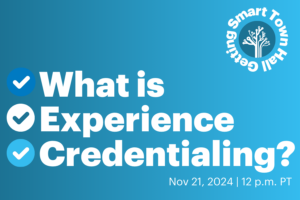Learner Profiles: The New Glue to Unbundled K-20

Higher education is going through a great unbundling where students bring credits with them, ask for credit for prior learning, and take online classes at other institutions. Investor and author Ryan Craig thinks many surviving institutions will shift to an “Education-as-a-Service” (EaaS) model, providing “students what they need when they need it: a ‘just-in-time’ educational model that is much closer to today’s coding schools than current degree programs.”
Something similar is happening in K-12, a trend I called “School-as-a-Service” (SaaS). In addition to a steady expansion of school options, there are a growing number of learning options for students. Most students have access to free online resources like Khan Academy. Some students have the opportunity to attend after school programs or visit a Boys & Girls Club, or join a robotics club. Most high school students have access to online courses; many can take courses that offer college credit.
As K-12 families bundle formal and informal learning services it will require access to and information about options. It will also be helpful to have weighted, flexible, portable funding.
A comprehensive learner profile will help learners, parents, and teachers track progress, coordinate services, and make informed decisions.
Learner profile. A learner profile includes transcript data such as grades, courses and state test results. A comprehensive profile also includes local assessments, record of services received, feedback on success skills, and work/service experiences. An accompanying portfolio allows students to collect their best work product.
With secure sharing agreements, an electronic profile equips teachers to personalize learning from day one. For special needs students that receive services inside and outside of school, a learner profile helps to coordinate services.
A group of Puget Sound districts have a data sharing agreement that allows them to share learner profiles with each other and (with parent permission) with student serving community organizations.
Education Savings Accounts. Another emerging application of the learner profile is the management of an Education Savings Account (ESA), a state sponsored program that allows parents to direct funding to schools, courses, programs, and services. ExcelinEd, which tracks ESA, says, “By allowing parents to plan for their child’s unique needs, ESAs create a personal approach to education, where the ultimate goal is maximizing each child’s natural learning abilities.”
Five states have enacted ESA programs, each with unique rules regarding eligible participants and uses. ExcelinEd notes that the first program was created in Arizona in 2011, followed by Florida in 2014, and Mississippi, Tennessee, and Nevada this year. The Nevada program extends eligibility to all 450,000 public school students in the state eligible, making it the country’s most expansive K-12 choice program (see program details).
More than 4,000 Nevada families have applied for the program which begins January 1. A learner profile system would help these families track student progress. A permission system would allow parents to provide partial or full read/write access to multiple providers.
For example, an online learning provider could provide ongoing feedback and a final grade for a Chemistry course; a mentor could comment on a student’s interpersonal skills development during an internship; a tutor (or tutoring system) could award a badge to a student’s portfolio for demonstration of learning.
Whether a traditional school environment augmented by an after school program and online resources or a full ESA program, learning is now an anywhere anytime multi-resource adventure. It should be facilitated by a learner profile.
For more check out:
- Data Backpacks: Portable Records & Learner Profiles
- Parent-Managed Learner Profiles Will Power Personalization
Stay in-the-know with all things EdTech and innovations in learning by signing up to receive the weekly Smart Update.






0 Comments
Leave a Comment
Your email address will not be published. All fields are required.